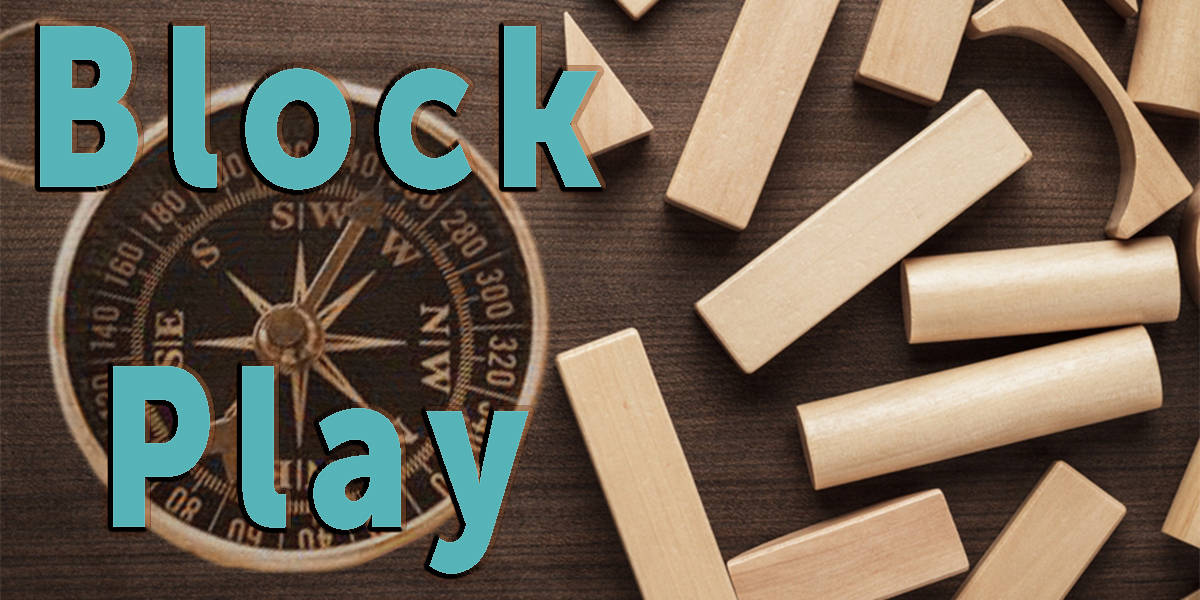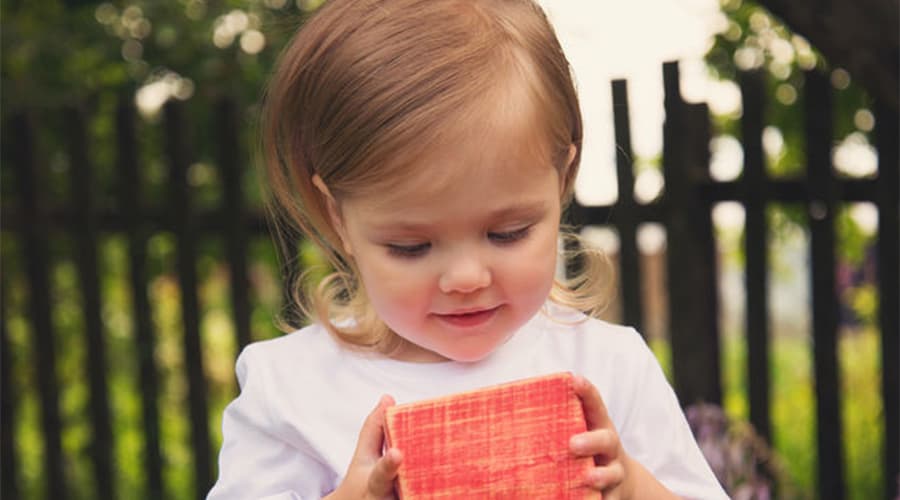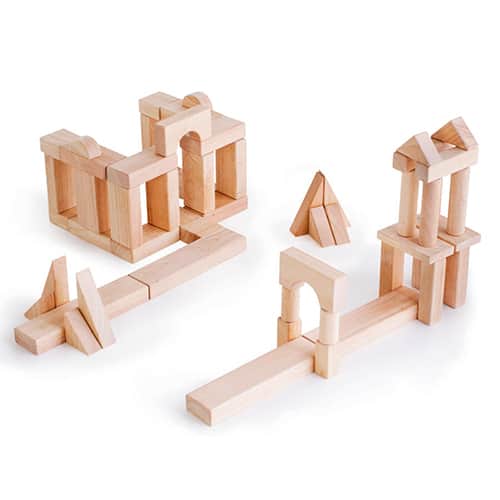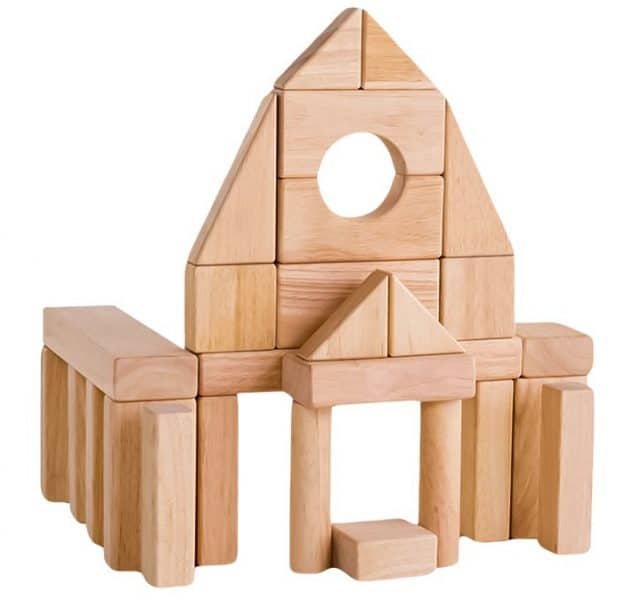Why block play, you ask? Well, blocks have been around for centuries. More than likely, you played with them, and so did your parents, even your grandparents and great-grandparents.
Building blocks are versatile, familiar, and readily available to all. Kids playing with blocks is almost like a rite of passage.
This post will be the first in a series about the importance of block play, the stages of block play, and how to set up a block play area. Throughout, we will offer some suggestions for block play activities and ways to encourage more building time at home.

What is Block Play?
Building blocks, toy blocks, building bricks, or just “blocks” come in various colors, shapes, sizes, and materials. These “blocks” or basic units are used to construct, compose, or build things. Most often associated with children, blocks transcend all ages for a fun interactive experience.
Block play offers a creative, open-ended, and valuable play experience for everyone. It provides children the freedom – to explore, take apart, and put back together any block-based creation they can imagine.
Block play is inclusive. There is no age, gender, or race bias. It opens new opportunities, regardless of whether your child plays alone, with a friend, or in a small group. There is nothing more satisfying than to see your child engaged in fun play experiences.
Building blocks are such a simple item with so many benefits.
Block Play and Child Development
Blocks have the ability to grow with your child through changing developmental stages. From stacking and knocking them over, creating bridges and enclosures, to complex building structures with a purpose. Incorporating blocks into dramatic play is a natural progression for children as they move through the various stages of block play.
Children love to challenge themselves; for example, you might hear them say, “I am going to build a tower up to the sky.” A child playing with building blocks will be engaged and entertained for hours on end. Why? Because there is always something new, fun, and stimulating to do with blocks.
Benefits of Block Play
The benefits of block play are unlimited. However, the real value is that it brings them pure joy! What children learn through block play is priceless!
The benefits of building blocks in early childhood typically fall into one of five categories essential to raising happy, healthy, and well-adjusted children.

Social Benefits
Block play, one of your child’s first experiences playing with others, is vital to developing social skills.
- It encourages social interaction that reinforces the skills needed for growth and development.
- They learn to make friends and build relationships.
- Whether building together or alongside one another, they must share and take turns.
- Working in small groups requires them to cooperate, negotiate, and compromise. For example, what if they both want the same block?
Often in block play, you will see the first signs of initiative, responsibility, and leadership. Working together on a structure requires children to collaborate towards a common goal.
What will they build?
How will they make it?
What role will each child fill?
The collaboration will be a give-and-take. Sit back and watch your child navigate these issues; it will be quite exciting!
As they create, build, and discover the world around them, block building provides an opportunity for self-expression. It fosters self-esteem, confidence, and autonomy by allowing children to take risks. Have you seen your child’s face after successfully building a tower taller than themselves? It is pure pride and joy!
Physical Benefits
Block play promotes the development of coordination and motor skills. Both fine and gross motor skills are strengthened as children lift, move, and build with blocks. Developing these motor skills is crucial to the success of everyday tasks and your child’s independence. See our post with 25+ Gross Motor Activities For Preschoolers And Toddlers.
Balancing blocks can be tricky; it requires skill, fine motor control, and a sense of balance. In addition, children playing with blocks boosts eye-hand coordination and spatial awareness. Here is a list of 25+ Fine Motor Activities For Preschoolers And Toddlers.
During the stages of block play, children start with carrying blocks. Next, they stack blocks, either vertically or horizontally. Later, they build bridges and enclosures, developing their understanding of spatial relationships. Spatial awareness is the ability to connect and interact with your surrounding environment. Critical for a kid’s growth, it supports full-body strength, flexibility, and balance.
Language benefits
Block play fosters vocabulary, communication, and language development. Children are verbal beings, whether narrating what they are doing or discussing the finer points of city-building with their friends. Have you ever sat back and listened to your kids playing with blocks? It can be like a front-row seat at the theater!
Building with blocks encourages dramatic play. Which, in turn, supports creating adventures and collective storytelling. As your child builds, so does the story encouraging their language and communication skills. Maybe the castle they just built needs a king or queen? How about some animals for the zoo?
When you engage in block play with your child, there are opportunities to develop new vocabulary—for instance, describing the blocks’ sizes, shapes, or colors—or perhaps describing the parts of the building or castle, like the floor, doors, windows, and so on.
Want more? Take a look at “Simple And Powerful Language Activities for Preschoolers.”
Creative Benefits
Block play inspires imagination and creativity. It stimulates children to be creators and builders, free to imagine their own designs. Often creating one adventure after another. Is it a zoo? Or a castle? How about an imaginary city underwater? Whatever it may be, the freedom to launch exploration is why building with blocks is so beneficial.
Blocks are loose parts, meaning they can be combined and redesigned in endless ways. Loose parts or “blocks” can be mixed with other materials or used alone. What’s important to remember is that there is “no right way,” and it is an open-ended, child-directed play. Adding extra building materials like paper tubes, floor samples, popsicle sticks, or cardboard expands the opportunities for creativity.
Creativity also plays a vital role in problem-solving. As a natural outcome, kids playing with blocks is problem-solving at its best! Through trial and error, building with blocks strengthens your child’s reasoning skills. Whether the building keeps falling over or the bridge collapses, there are exercises in finding a solution. Consciously or not, anything they build will require logical thinking skills. Problems will occur, and firsthand they will discover what does and doesn’t work.
Cognitive Benefits
Here at Discovery Building Sets, we like to focus on free playtime and its benefits. Block play provides fun, spontaneous, and imaginative play, all while building cognitive skills. No agenda or structured activities are required.
Science
Children building with blocks, explore, and discover many early science concepts.
- For example, they become aware of weight, balance, and gravity.
- As they experiment with cause and effect, they uncover how a block reacts when added to the top of another one. Why did the tower come crashing down?
- Through trial and error, they begin to better understand how to balance the blocks and defeat gravity.
Math
Through block play, numerous math concepts are introduced.
- Building with blocks brings understanding to taller, shorter, wider, longer, higher, heavier, and more.
- They begin to form patterns, and symmetry becomes important to their building.
- Things like value and numbers, measurements, comparison, and basic geometry are explored.



As you can see, the benefits of block play are many. Why not grab a set of wooden building blocks, get down on the floor with your child, and engage in some quality block play?
